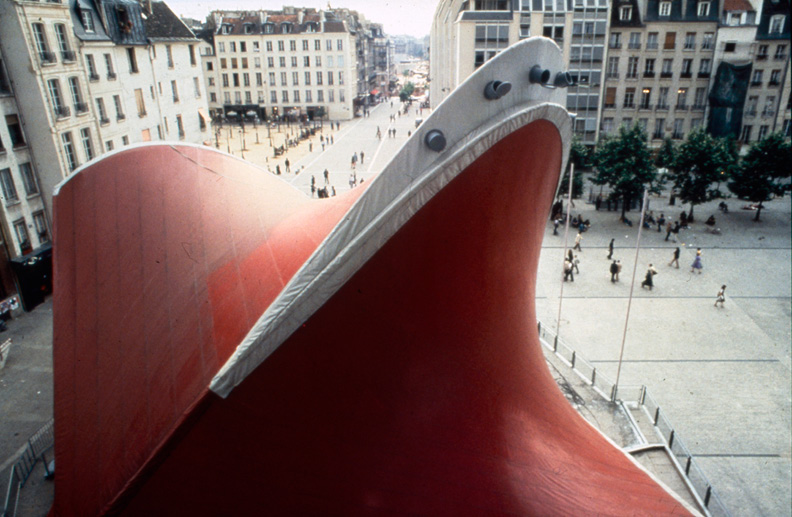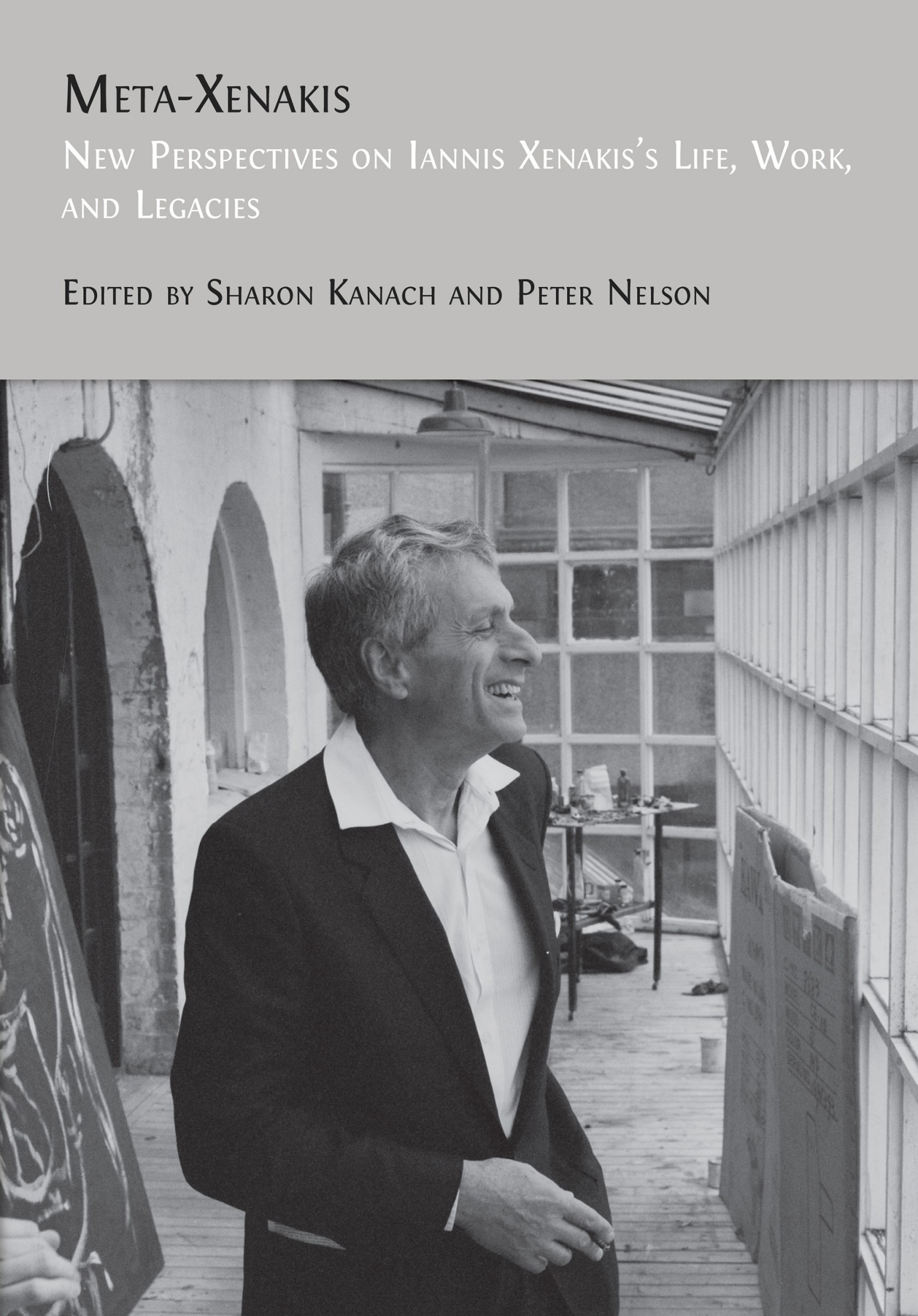Prolegomenon: Meta-materiality in the Thought and Creative Activity of
Iannis Xenakis
James Harley
© 2024 James Harley, CC BY-NC 4.0 https://doi.org/10.11647/OBP.0390.02
Iannis Xenakis (1922–2001) is primarily known as a music composer, but he was actually many things. The confluence of his various abilities and interests, what has been called his “alliages-alloys,”1 leads to the notion of “meta-materiality.” This study seeks to explore the ways in which Xenakis’s multifaceted work grew out of mathematical abstraction and discipline that could be applied to a wide range of creative projects incorporating elaborate technical materials.
Xenakis possessed an enormous capacity to absorb different sorts of information, and to apply these inputs to his creative and technical work. This capacity developed during his training as an engineer and his time working for the famed architect Le Corbusier (1947–59); in his final project for Le Corbusier, the Philips Pavilion (for the 1958 World Fair in Brussels), he served as project coordinator, working with architects, engineers, construction contractors, audiovisual designers, and more.2 Engineering is a discipline where a rigorous training in foundational knowledge such as mathematics is allied with practical applications. As a professor, and in interaction with younger composers and musicians, he invariably advised people to study mathematics. This conviction was most strongly expressed in his counsel to his own daughter Mâkhi, who rebelled against this advice to become a visual artist.3 Reflecting on his own formation, Xenakis thought of himself as being shaped from a “mosaic of coherences.”4 He moved, conceptually, from the field of Philosophy, “Thrust towards truth, revelation. Quest in everything, interrogation, harsh criticism, active knowledge through creativity”5 to the fields of the Arts (partially inferential and experimental), Sciences (of man, natural), and Physics, Mathematics, and Logic (entirely inferential and experimental).6 He then moved on to categorizing questions (found in many fields) and from there to sorting types of solutions or procedures for solving questions, and then to examining specific compositions (examples of particular realizations, musical works).7 Clearly, Xenakis placed music (and arts-based creative activity) within a larger, classical educational context: Trivium (primary stage)—Grammar; Logic; Rhetoric; then the Quadrivium (secondary stage)—Arithmetic (abstract); Geometry (spatial); Music (temporal); Astronomy (spatial and temporal). Later, when he had occasion to reflect on his trajectory, in particular when he presented his work and writings for a Doctorat d’État in 1976, he articulated the aesthetic/philosophical basis of his activities.8
All the work I have done over the years is a sort of mosaic of hierarchical coherencies. At the hierarchy’s summit I’d place philosophy… in the sense of the philosophical impulse which pushes us toward truth, revelation, research, general quest, interrogation, and harsh systematic criticism, not only in specialized fields but in all possible domains. This leads us to an ensemble of knowledge which should be active, in the sense of “doing.” Not passive knowledge but knowledge which is translated into creative acts. I repeat, in all possible domains…. One can divide this coherency mosaic into three categories or three chapters. The first is the method which allows us to obtain this active knowledge through creativity—which (through theoretical demonstration) implies inference, meaning reason, logic, etc. Following these criteria, there are aspects of activity and knowledge which are partially inferential, entirely inferential and experimental, and others which remain unknown.9
In his “Table (mosaic) of Coherences” he lists musical compositions exemplifying “categories of questions,” from indeterminism to determinism: under the heading Free Stochastic he lists Achorripsis (1957), ST/10 (1962), ST/48 (1962), Morsima-Amorsima (1962), Atrées (1963); under Markovian he lists Analogique A + B (1958–9), Syrmos (1959); under Games he lists Duel (1959), Stratégie (1962); and under Groups he lists Akrata (1964), Nomos Alpha (1966), Nomos Gamma (1967).10
Turning back to his chronology and formation as a composer, it is clear that Xenakis built on his classical schooling with advanced engineering studies (Athens Polytechnic, 1940–6), all while carrying on an interest in music and other arts (especially ancient Greek literature and architecture).11 In the realm of Western music, exemplified by the conservatory approach to musical training (including composition), the cross-fertilization with other disciplines became quite restricted.12 The increasingly elaborate techniques being explored by composers made the music and related techniques more hermetic. For Xenakis, however, his particular educational background, carried out in Greece under the heritage of Plato, Aeschylus, etc., made it more natural for him to adapt tools and approaches from other disciplines, building on the core elements of mathematics, philosophy, etc. Xenakis found a little training in harmony and counterpoint during his years in Athens. But his main academic focus was on engineering, and the political upheavals and strife through those years made other extracurricular pursuits difficult. When he got to Paris in 1947 though, Xenakis quickly made music his main focus, beyond his “day job” in Le Corbusier’s architectural studio. He sought advice and instruction from the best the city had to offer. In 1948 he approached Arthur Honegger (1892–1955) at the École Normale. He then approached Darius Milhaud (1892–1974) in 1949 at the Paris Conservatoire. Apparently not finding a good match working with these venerable but somewhat conservative composers, he then sought out Nadia Boulanger (1887–1979), most well-known as a pedagogue, who did not accept Xenakis as a student but whose assistant Annette Dieudonné (1896–1990) recommended he approach Olivier Messiaen (1908–92), who was teaching at the Paris Conservatoire. Messiaen saw something worthwhile in the fledgling composer and permitted Xenakis to audit his classes over three years, 1951–4. This period saw a remarkable development in Xenakis’s scores, and a reference from Messiaen also opened the door to electroacoustic music through an apprenticeship at (what is commonly known as) the Groupe de Recherches Musicales at Radio France, where he worked in various capacities from 1955–62. This period was fruitful in many ways. For example, during this time another mentor, conductor Hermann Scherchen (1891–1966), encouraged Xenakis, among other things, to articulate his ideas in print. His first articles date from 1955: “Problems of Greek Musical Composition” and “The Crisis of Serial Music.” Subsequent articles led to what became the book Formalized Music.
The transference of ideas from those other disciplines, especially mathematics, into music had the effect in Xenakis’s work of creating highly original scores and sounds: firstly, the geometrical principles underlying hyperbolic paraboloids as they were being explored in architecture turned into webs of string glissandi in Metastasis (1953–4), and were further explored in string works such as Syrmos (1959). Secondly, the probability functions used in risk analysis in engineering and other disciplines were applied to generative applications in creating complex, granular “clouds” of sound in Pithoprakta (1955–6) for orchestra, Concret PH (1958) for electroacoustics, or Analogique A & B (1959) for strings and electroacoustics. And thirdly, his detailed understanding of computer programming led to the ST family of algorithmic instrumental works in 1962, while his familiarity with the intricacies of linking software to digital audio-oriented computer hardware led to a unique graphical-based synthesis system, the UPIC (Unité Polyagogique Informatique de CEMAMu); through this system, Xenakis created a series of electroacoustic compositions, from Mycènes Alpha (1978) to Voyage absolu des Unari vers Andromède (1989). Further work in digital audio led to a new approach to sound synthesis: General Dynamic Synthesis (GENDYN). Preliminary work on what he also called “stochastic synthesis” provided material he incorporated into Polytope de Cluny (1972–4) and La Légende d’Eer (1978). GENDYN software led to two computer-generated works: Gendy3 (1991) and S.709 (1994).

Fig. 0.1 Aerial view of Xenakis’s Diatope, Paris, 1978. Photo by Bruno Rastoin (1978). Archives of Centre Iannis Xenakis, Rastoin collection.
His engineering background also supported his ability to develop unique multimedia presentations involving digitally controlled lighting systems with hundreds of flashbulbs and laser displays guided by movable mirrors. His first involvement with such projects occurred with the Philips Pavilion in 1958; he was primarily involved in the architectural design of the pavilion and its construction, but he witnessed and supported the presentations that included hundreds of loudspeakers, lights, projected film, and sculptural elements (his musical contribution was the short electroacoustic work, Concret PH, intended as an interlude as people entered and exited the pavilion between performances). With the Polytope de Montréal (1967), he was able to create an installation that included music (originally scored for four spatially separated ensembles, but in the end projected on loudspeakers from a four-channel tape), strung cables forming designs reminiscent of the linear, geometrical glissando shapes used in Metastasis, and hundreds of programmable flashbulbs strung along the cables stretching over the five floors of the atrium space he was working with. He did not have the opportunity to create the architecture, but the installation became the highlight of the pavilion. The Polytope de Cluny provided another opportunity to create an installation, this time in an historical site in Paris and with the addition of lasers. He also created polytopes for outdoor historical sites: Persepolis (1971) and Polytope de Mycènes (1978). Perhaps the epitome of Xenakis’s meta-materiality is his Diatope (1978), a work combining architecture, music with computer-controlled spatialization, lights (flashbulbs and lasers), and a significant program text combining philosophy, history, and aesthetics.13
For Xenakis the polymath, it was natural to draw concepts and techniques into his creative work from various disciplines. Messiaen’s advice to his extraordinary student who had very little traditional background or training in music proved prescient: “I encouraged him to use his mathematical and architectural knowledge in his own music and not to worry about melodic—harmonic—contrapuntal—rhythmic problems.”14 Of course, these elements are essential to whatever music is being created, but the techniques for handling them can come from musical traditions or from other disciplines. The meta-materiality of Xenakis’s work is the core of his truly original contributions.
The artist-conceptor will have to be knowledgeable and inventive in such varied domains as mathematics, logic, physics, chemistry, biology, genetics, paleontology (for the evolution of forms), the human sciences and history; in short, a sort of universality, but one based on, guided by and oriented toward forms and architectures. Moreover, the time has come to establish a new science of “general morphology” which would treat these forms and architectures within these diverse disciplines in their invariant aspects and the laws of their transformations which have, in some cases, existed for millions of years. The backdrop for this new science should be the real condensations of intelligence; in other words, an abstract approach, free from anecdotes of our senses and habits.15
References
HARLEY, James (2004), Xenakis: His Life in Music, New York, Routledge.
MATOSSIAN, Nouritza (1986), Xenakis, London, Kahn and Averill.
XENAKIS, Iannis (1971), Formalized Music, Bloomington, Indiana, University of Indiana Press.
XENAKIS, Iannis (1985), Arts-Sciences, Alloys: The Thesis Defence of Iannis Xenakis before Olivier Messiaen, Michel Ragon, Olivier Revault d’Allonnes, Michel Serres, and Bernard Teyssèdre, translated by Sharon Kanach, Hillsdale, New York, Pendragon.
XENAKIS, Iannis (2008), Music and Architecture: Architectural Projects, Texts, and Realizations, translated, compiled and presented by Sharon Kanach, Hillsdale, New York, Pendragon Press.
XENAKIS, Mâkhi (2022), Iannis Xenakis: Un père bouleversant, Arles, Actes Sud.
1 The French term to convey the conceptual amalgam of arts-sciences, “alliages,” was translated as “alloys” in English (Xenakis, 1985).
2 And, at the same time, carrying on his activities as a composer, working at the GRM (Groupe de Recherches Musicales) studios, writing substantial articles on music and architecture.
3 Xenakis, 2022.
4 Xenakis, 1971, p. viii.
5 Ibid.
6 Ibid.
7 Xenakis’s music is discussed comprehensively in Harley, 2004.
8 Xenakis, 1985.
9 Ibid., p. 7–8.
10 Xenakis, 1971, p. viii.
11 Xenakis’s biography has been most thoroughly presented in Matossian, 1986.
12 In the conservatory model, music students study and learn in an isolated environment, usually separate from a wider university-type educational environment.
13 Xenakis’s multimedia and architectural works are presented in detail in Xenakis, 2008.
14 Matossian, 1986, p. 10.
15 Xenakis, 1985, p. 3.
